Are you wondering what content marketing metrics you should monitor to ensure your strategy is successful?
Content marketing metrics are essential for understanding the impact of your content. Tracking these metrics helps you see what works, find ways to engage your audience better, and grow your business.
In this article, we’ll cover 16 content marketing metrics that matter the most. We’ll talk about why it’s important to measure them, discuss common content marketing goals, and highlight the key metrics depending on your business type.
Let’s dive in!
- Why Monitor Content Marketing Metrics?
- Most Common Content Marketing Goals
- 16 Content Marketing Metrics That Matter the Most
- Content Marketing Metrics to Monitor for Different Businesses
Why Monitor Content Marketing Metrics?
First, let’s talk about why monitoring content marketing metrics and performance is important. Here are some key reasons:
- Understand audience preferences: Learn what your audience likes and dislikes by tracking which content gets the most views, shares, and comments.
- Improve content quality: Identify which types of content perform best so you can create more of what works and less of what doesn’t.
- Boost engagement: Discover ways to keep your audience interested and engaged by seeing what kind of content they interact with the most.
- Increase ROI: Measure the return on investment for your campaigns to ensure your content marketing efforts are paying off.
- Guide future strategies: Use the data you collect to plan your future content marketing strategies more effectively.
- Measure Success: Know if your campaigns are working by setting clear metrics and tracking your performance against them.
Monitoring the performance of your content marketing strategies helps you make informed decisions and improvements. This will ultimately lead to success by increasing your traffic, engagement, and potential sales.
Now, let’s cover some common content marketing goals and key performance indicators (KPIs).
Most Common Content Marketing Goals
Depending on your type of business, you might have different goals for your content marketing. These goals help measure the success of your content efforts and can vary based on your overall strategy, target audience, and the type of content you make.
Here are some common content marketing goals:
- Brand Awareness: Increase your brand’s visibility and recognition among your target audience by creating content that discusses your brand and its values.
- Lead Generation: Attract and convert visitors into leads with content that includes calls to action (CTAs) to capture contact information.
- Engagement: Enhance interaction with your audience by focusing on content that encourages likes, shares, comments, and other forms of engagement.
- Customer Education: Inform and educate customers about your products or services using tutorials, webinars, and how-to guides to help them make informed decisions.
- SEO Improvement and Traffic Generation: Boost organic search rankings and increase website visitors by creating SEO-optimized content.
- Thought Leadership and Authority: Establish your brand as a leading authority in your industry with insightful, innovative content showcasing your expertise.
- Customer Retention and Loyalty: Keep existing customers engaged and loyal by sharing success stories, updates on new features, and exclusive offers.
- Sales Support: Provide relevant content, such as case studies and product sheets, to assist the sales process and help close deals.
- Market Expansion: Reach new market segments or geographic areas by creating content tailored to new audiences.
Ultimately, the key content marketing metrics that a business should focus on depend on its unique goals and objectives. So, if you’re just starting out as a business, think about what you want to achieve.
Now, let’s dive into the most important content marketing metrics.
16 Content Marketing Metrics That Matter the Most
1. Organic Search Traffic
Organic search traffic is the number of visitors who come to your website through search engines like Google, without clicking on paid ads.
This metric shows how well your content ranks in search results and helps you understand the effectiveness of your SEO efforts.
This type of traffic is cost-effective since it’s free, unlike paid ads. Additionally, visitors who come through organic search are often more engaged, as they found your content through their own searches and are genuinely interested in what you offer.
To check it in Google Analytics, log in to your Google Analytics account. Go to the Acquisition tab on the left and go to Traffic Acquisition. Look for the Organic Search row in the table to see your organic search traffic.
For WordPress users, MonsterInsights can effortlessly track organic search traffic right from the WordPress dashboard.
MonsterInsights is the best Google Analytics plugin for Wordpress, allowing users to connect their WordPress websites to Google Analytics without using any code.
To view organic traffic, simply go to Insights » Reports » Traffic Overview:
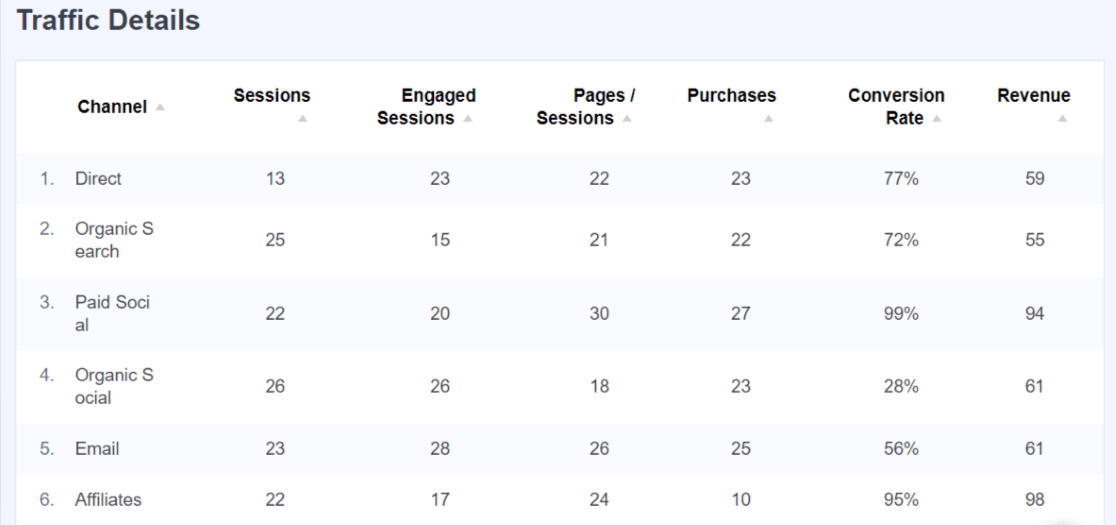
Tracking organic search traffic helps you understand how well your content is performing in search engines and is a good indicator of whether your current content strategy is working.
Read our guide on How to Increase Organic Traffic (12 Best Ways) to learn more.
2. Views
Views refer to the total number of times your web pages or app screens are visited. This metric helps you understand which content pieces are most popular among your audience.
It’s important because it shows you which content resonates most, helping you identify high-performing pages and understand what topics or formats attract the most attention.
In Google Analytics, go to the Reports » Engagement » Pages and Screens to see the total number of views for different web pages.
For WordPress users, MonsterInsights provides this information in the Pages Report, which gives a deeper dive into your site’s top pages, showing views, session data, and bounce rate for each visited page:
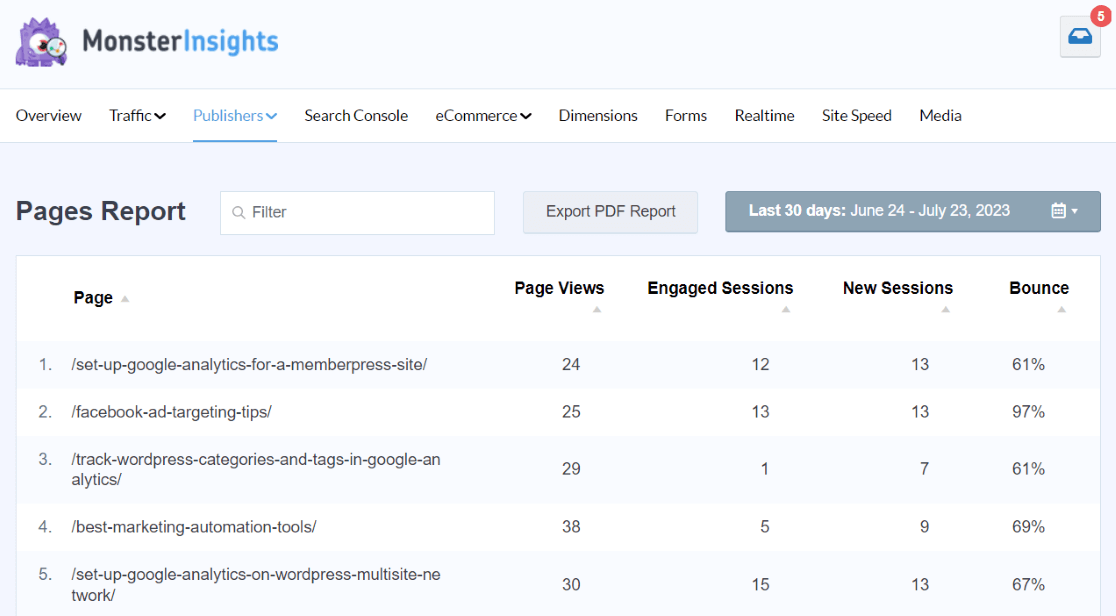
Tracking views helps you identify your most popular content and understand what attracts your audience, guiding you to create more of what they love.
3. Traffic Sources
Traffic sources, such as search engines, social media, direct visits, or other websites, tell you where your visitors are coming from.
Understanding traffic sources helps you see which channels drive the most visitors to your site and which marketing efforts are most effective.
Check traffic sources in Google Analytics by going to Acquisition » Traffic Acquisition and selecting Source/Medium in the report dropdown:
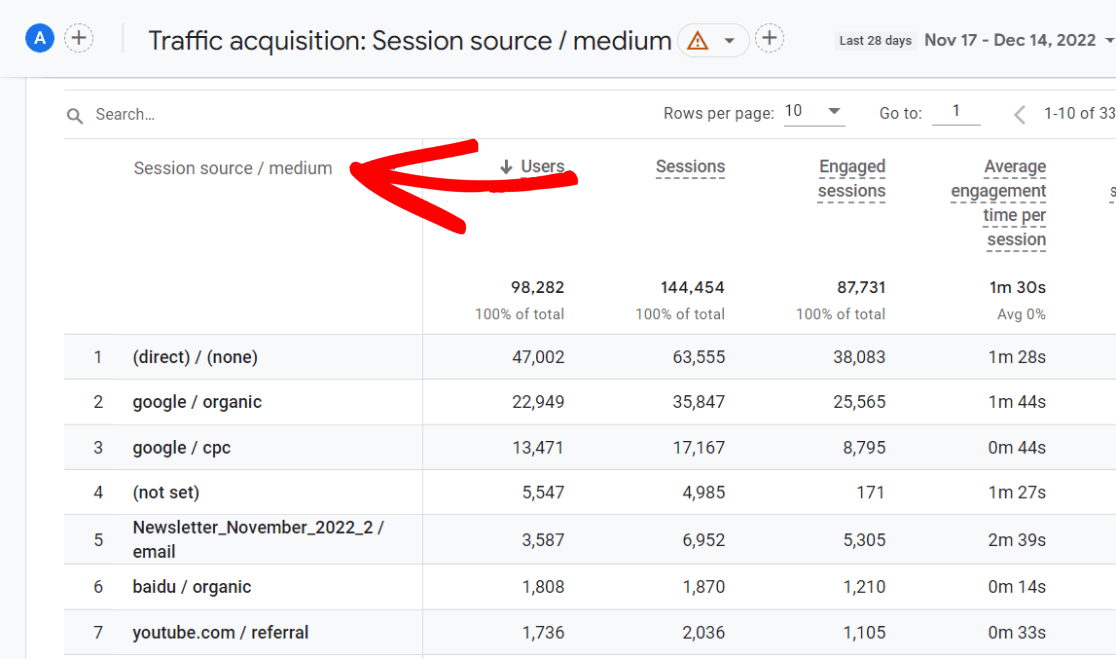
For WordPress and MonsterInsights users, you can find this information in the Source/Medium report. This report provides more details on exactly where your visitors came from, giving you a clear picture of your traffic sources:
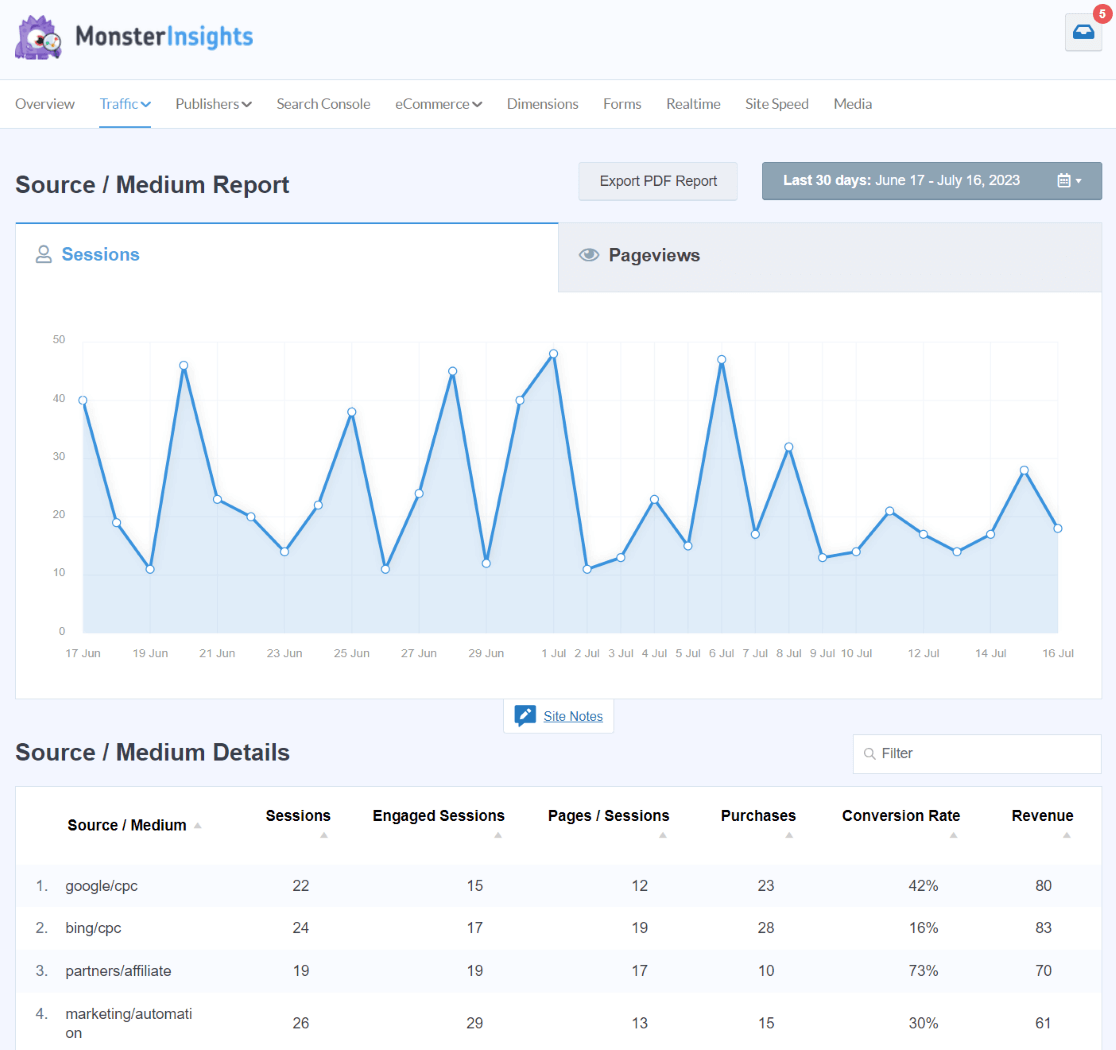
Tracking traffic sources helps you understand which channels are most effective at bringing visitors to your site. This knowledge allows you to focus your marketing efforts on the channels that work best for your business.
4. Keyword Rankings
Keyword rankings refer to where your website appears in search engine results for specific keywords. Keeping track of these rankings helps you understand how well your SEO efforts are working and which keywords are driving traffic to your site.
To keep track of your keyword rankings, you can use Google Search Console. Log in to your Google Search Console account and go to the Performance tab.
For WordPress users, MonsterInsights offers a convenient way to track keyword performance. Click on the Search Console tab to find your Top 50 Google Search Terms:
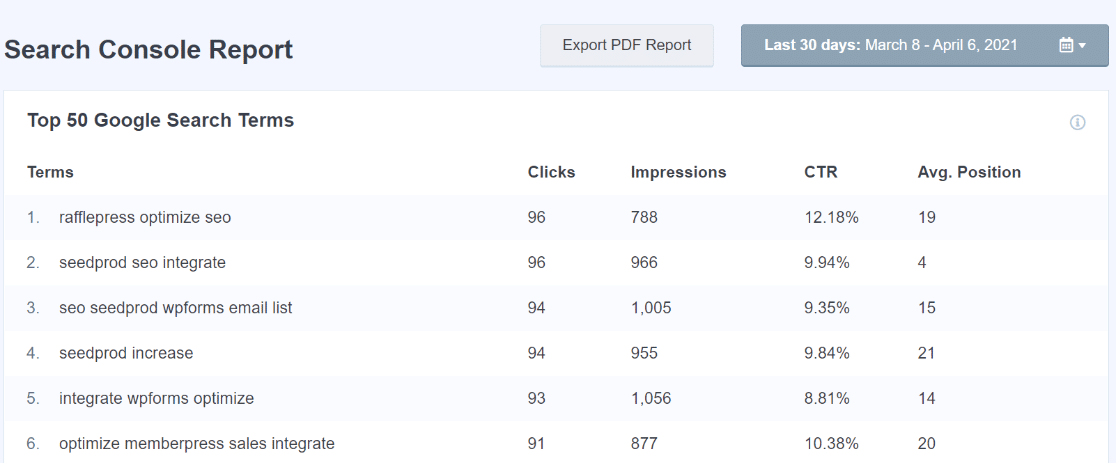
Additionally, MonsterInsights allows you to track focus keywords using the Custom Dimensions report. With a click of a button, you can track your All in One SEO (AIOSEO) or Yoast keywords directly within WordPress and get a detailed report in your dashboard:
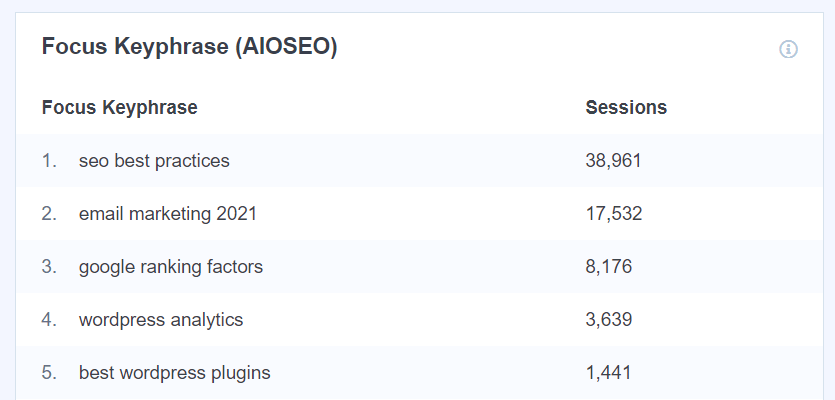
By monitoring keyword rankings, you can adjust your SEO strategy to improve your website’s visibility, attract more organic traffic, and ensure you are targeting the right keywords for your business.
Read our full guide on How to Track Organic Keywords in Google Analytics + WordPress to learn more.
5. Impressions
Impressions measure how often your content, like ads or social posts, is displayed to users.
Impressions are important because they show the reach of your content, helping you understand if your marketing efforts effectively get your content in front of your target audience.
To track impressions, use the analytics tools provided by each platform. For digital ads, check Google Ads or LinkedIn Analytics. Use Facebook Insights, Twitter Analytics, or Instagram Insights for social media posts.
Monitoring impressions helps you understand how widely your content is being seen and guides you in increasing visibility to reach a larger audience.
6. Click-through-rate (CTR)
Click-through rate (CTR) measures the percentage of people who click on your content after seeing it. A high CTR indicates that your content is relevant and appealing to your audience.
To track CTR using Google Search Console, log in to your account and go to the Performance tab. Here, you can see the CTR for your pages and keywords.
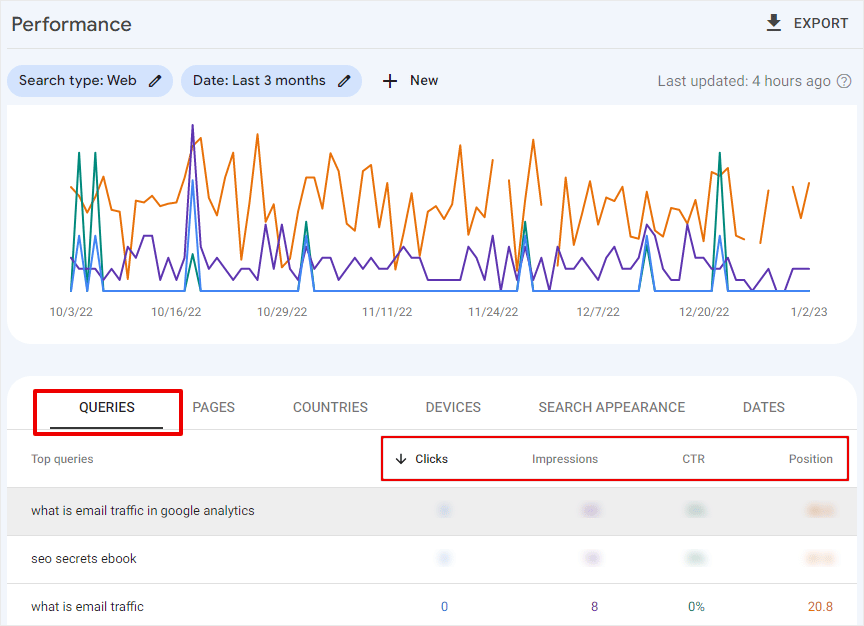
Monitoring CTR helps you optimize your content to make it more engaging and effective at driving traffic to your site.
Check out our guide on How to Improve CTR in 5 Minutes or Less: 27 Simple Ways.
7. Average Engagement Time
Average engagement time measures how long visitors stay engaged on your web pages. This metric indicates how relevant and interesting your content is to your audience.
To check the average engagement time spent on your pages using Google Analytics, go to the Engagement tab » Pages and Screens. Here, you’ll see the average engagement time on each page.
Monitoring the average engagement time helps you see the engagement level of your content, allowing you to identify which pages hold your audience’s attention and which may need improvement.
8. Engagement Rates
Engagement rates measure how actively users interact with your content. This includes metrics like clicks, shares, comments, and time spent on the page, showing your audience’s interest in your content.
For social media performance, it’s easy to monitor these metrics from your social media platforms.
Monitoring engagement rates helps you understand which content resonates best with your audience, allowing you to create more of what they love and keep them coming back for more.
We recommend you check out our guide on 8 Proven Ways to Increase User Engagement on Your Website.
9. Bounce Rate
Bounce rate indicates the percentage of visitors who leave your website after viewing only one page.
A high bounce rate can suggest that visitors are not finding what they’re looking for or that your content is not engaging enough to keep them on your site.
A lower bounce rate typically means that visitors are exploring more of your site, which can lead to higher engagement and conversions. Additionally, bounce rate is a significant factor for SEO, as search engines consider it when ranking your site.
You can use Google Analytics to track your bounce rate.
For MonsterInsights users, the bounce rate is displayed in various reports, such as the Overview Report for overall site performance and the Pages Report for the bounce rate of individual pages.
Read our guide on How to Reduce Bounce Rate: 7 Simple, Proven Methods.
10. Backlinks
Backlinks are links from other websites pointing to yours.
Counting the number of high-quality backlinks is important because they can enhance your website’s credibility and improve your search engine ranking.
To monitor the number and quality of backlinks, use a tool like Semrush’s Backlink Analytics. This tool provides detailed insights into your backlinks, helping you understand your link profile and identify opportunities for improvement.
For MonsterInsights users, the Referrals report shows which websites most refer people to your site. You can view this report to see which sites are linking to you and driving traffic:
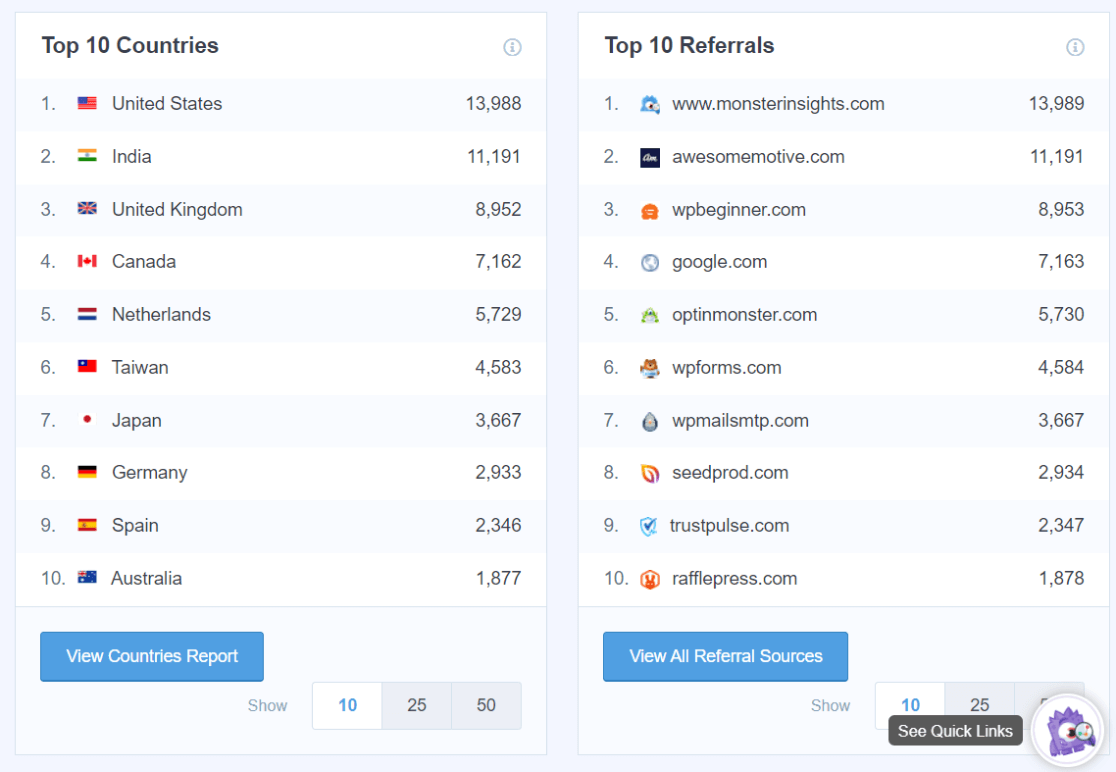
Tracking backlinks helps you understand the strength of your link profile, which is crucial for SEO.
Read our guide on How to Get Backlinks (15 Quick and Simple Strategies) for effective strategies.
11. Conversion Rates
Conversion rates measure the percentage of visitors who complete a desired action on your website, such as signing up for a newsletter or purchasing.
You need to set up conversion events in Google Analytics to calculate conversion rates. This allows you to track the percentage of visitors completing desired actions on specific landing pages. However, this is a bit difficult if you’re not tech-savvy.
Setting up conversion tracking is effortless for MonsterInsights users. MonsterInsights allows you to track various types of conversions, such as form submissions, eCommerce transactions, ad clicks, and more.
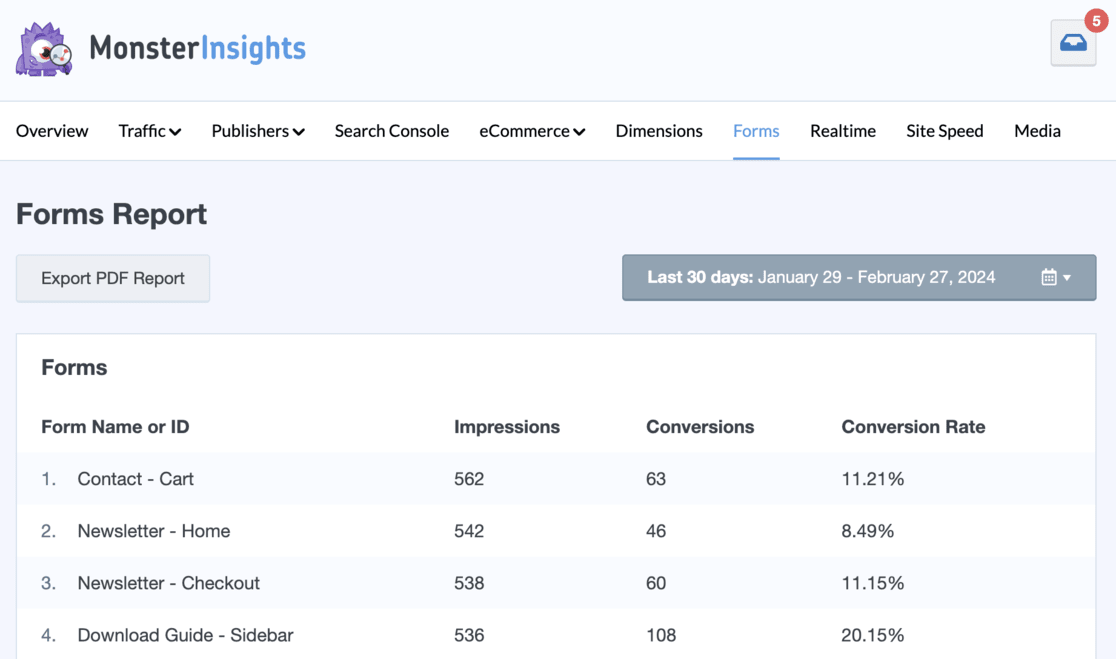
Read our Complete Guide to GA4 Conversion Tracking for WordPress to learn more.
12. Content Shares
Content shares measure how often people share your content with their own audiences. This is a true test of how useful or interesting your content is. When people share your content, it indicates that they find it valuable enough to recommend to others.
If you’re posting on social media, shares are easy to track through the platform’s analytics tools. For blog content, you can use tools like BuzzSumo to see how often your content is shared.
Monitoring content shares helps you understand which content resonates most with your audience and encourages them to spread the word. This feedback is invaluable for creating more shareable, engaging content in the future.
13. Lead Generation Metrics
Lead generation metrics track the number of leads generated through your content, indicating how effectively your content attracts and converts potential customers.
To track leads, you can use CRM software or set specific conversion goals in Google Analytics, depending on how leads are captured, such as through form submissions or sign-ups.
Similarly to conversion tracking, MonsterInsights makes tracking lead generation from your content or website effortless. You can track various actions like signups and purchases, but also sources like link clicks, button clicks, QR codes, SMS campaigns, and more using UTM parameters:
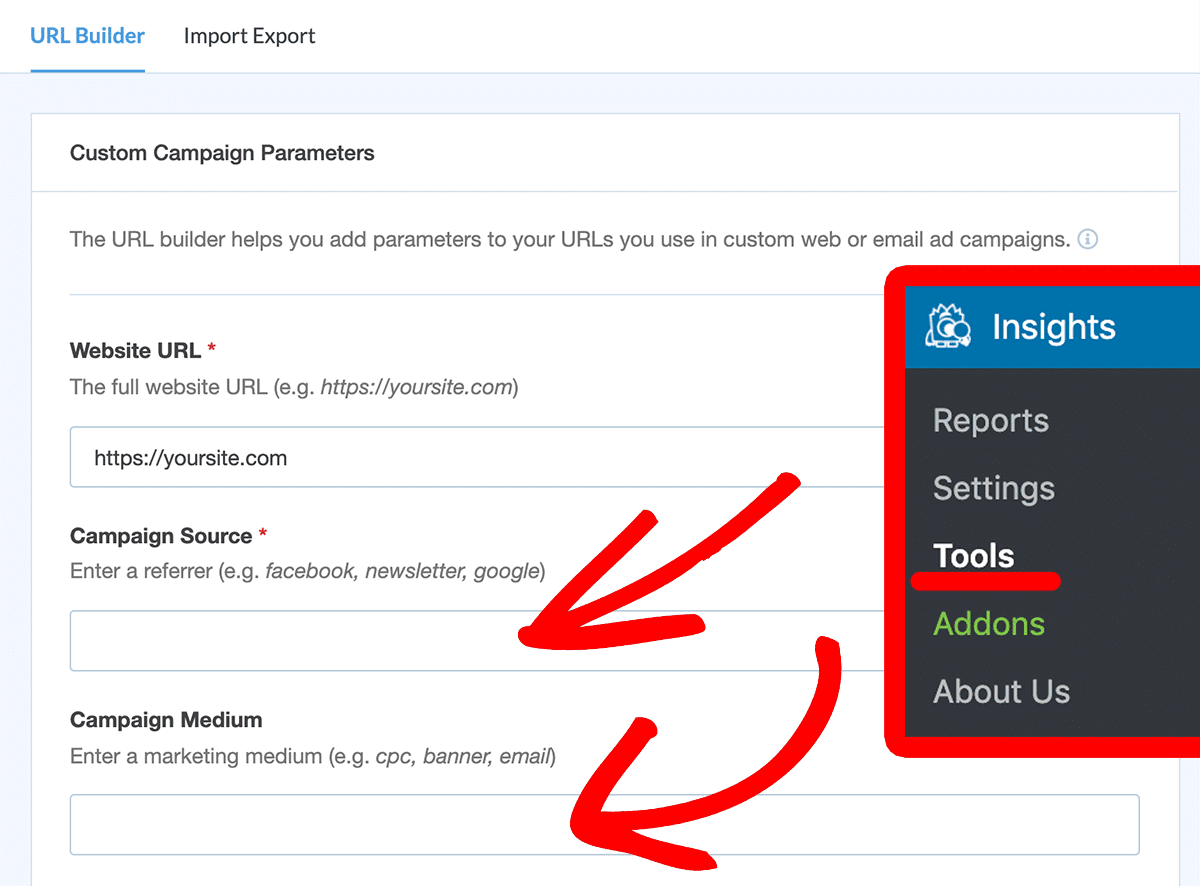
This comprehensive tracking allows you to see exactly how your content results in lead generation.
Read our Beginners Guide to UTM Parameters (And How to Use Them) to learn more.
14. Brand Mentions
Brand mentions track references to your brand, product, or service online, helping you see the public perception and the reach of your content. This way, you can see how often people are talking about your brand and what they are saying.
Tools like Google Alerts and Semrush’s Brand Monitoring can track online mentions of your brand across various platforms. These tools notify you whenever your brand is mentioned, allowing you to respond quickly and engage with your audience.
15. Follower/Subscriber Growth
Follower and subscriber growth measures the number of new followers or subscribers you gain over time. This metric is essential for understanding the reach and popularity of your content and overall brand.
For email subscribers, tracking growth helps you see how effectively your content encourages visitors to sign up for your newsletter or other email communications.
Follower growth on social media indicates how well your content resonates with your audience and how successful your social media strategies are in attracting new followers.
Monitoring follower and subscriber growth provides insights into your content’s appeal and your audience’s interest in staying connected with your brand. This growth is crucial for expanding your reach and building a loyal community around your content.
16. Email Engagement Metrics
Email engagement metrics measure how effectively your email campaigns resonate with your audience. These metrics include your email content’s open rates, click-through rates, and conversion rates.
You can see most of these metrics in your email marketing tool or platform, such as Constant Contact or Brevo. These tools provide detailed reports on your emails’ performance, helping you track and analyze key engagement metrics.
Monitoring email engagement metrics ensures that your email campaigns are effective, allowing you to refine your strategy to better connect with your audience and achieve your marketing goals.
Read our guide on the best Email Marketing Metrics and KPIs to Watch.
Content Marketing Metrics to Monitor for Different Businesses

Now that you’ve learned about the most important content marketing metrics, it’s time to understand which ones to focus on depending on the type of business you have.
Here are tailored metrics for new or small businesses, established businesses, and eCommerce businesses.
Content Marketing Metrics For New or Small Businesses
For new or small businesses, the focus should be on building visibility and engagement. Key metrics to monitor include:
- Brand Awareness
- Organic Search Traffic
- Social Media Engagement
- Subscriber Growth
- Content Shares
Content Marketing Metrics For Established Businesses
Established businesses should concentrate on maintaining and improving their market position. Important metrics to track are:
- Lead Generation
- Conversion Rates
- Engagement Metrics
- Customer Retention and Loyalty
- SEO Improvement
Content Marketing Metrics For eCommerce Businesses
eCommerce businesses need to focus on driving sales and customer loyalty. Essential metrics to monitor include:
- Conversion Rates
- Sales and Revenue
- Cart Abandonment Rates
- Customer Lifetime Value (CLV)
By focusing on the right metrics, businesses of all types can effectively measure and enhance their content marketing strategies.
And that’s it.
We hope you liked this guide on monitoring the most important content marketing metrics. Maybe you’d also like to read:
- Improve Content Marketing ROI in 10 Steps
- 8 Best SEO Content Checker Tools for Content Optimization
- 17 Best Content Marketing Plugins and Tools for WordPress
- 15 Content Repurposing Tips to Boost Website Traffic
Not a MonsterInsights user yet? Get started today!
Remember to follow us on X, Facebook, and YouTube for more reviews, tutorials, and helpful Google Analytics tips.


What are your thoughts about tracking Engaged Sessions? We’re a B2B service company (metal fab) and our site is essentially an online reference tool (I hope). I struggled for a long time to find a relatively simple metric to share to my non-GA savvy boss so he can see how effective our site has been. For us, it’s engaged sessions.
A week ago, I asked Andy Crestodina (via LinkedIn Messenger) his recommendation for such a metric. And, fwiw, he suggested engagement rate.
Hi Dave – Engagement in general is a great metric to track. It goes beyond just visits to the site to focus on the traffic that actually interacts with your site in some way, whether it’s clicking on something or staying long enough to read your content. I’d say either of those engagement metrics (sessions or rate) are good indicators of your website’s success to give your boss. You could also go with scroll depth, average engagement time per session, and conversions (key events). You could even try asking a basic question in a pop-up feedback survey (can do this with UserFeedback for free), like “Did you find what you were looking for?” and give him the results there. I know brochure-type websites can be harder to track the success of – hope these few tips help!